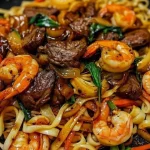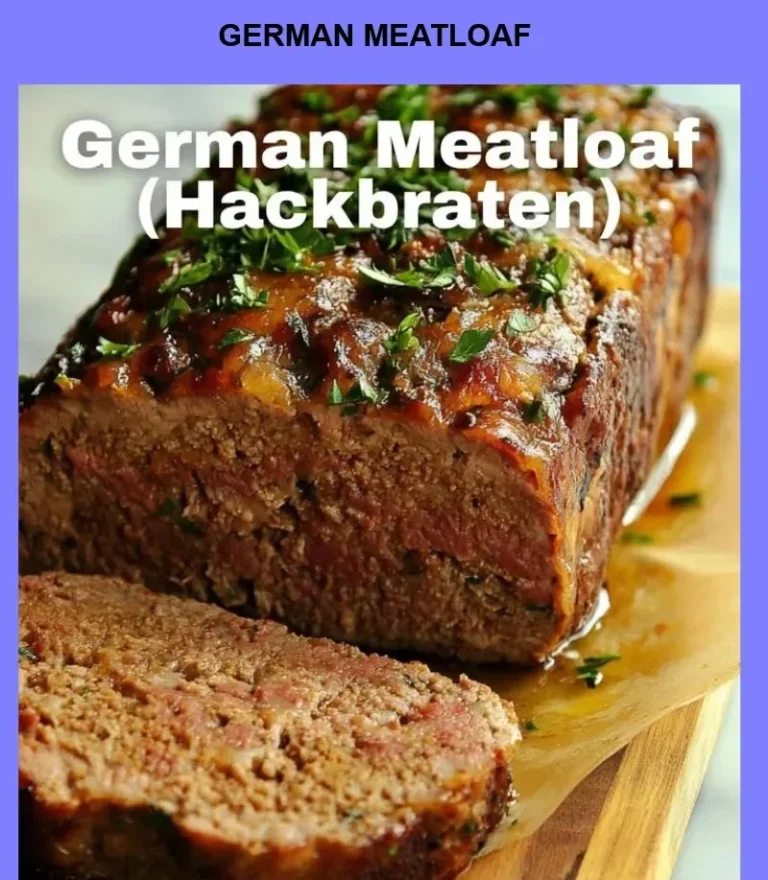German Beef Noodle Soup


Easy Homemade Traditional German Beef Noodle Soup — Healthy, Comforting & Cozy
The aroma of simmering broth and tender beef always takes me back to rainy afternoons at my grandma’s kitchen. German Beef Noodle Soup was what she’d make when the house felt cold and everyone needed a little comfort. The first spoonful—warm broth, soft noodles, and meltingly tender beef—felt like a hug in a bowl.
This easy, traditional, homemade German Beef Noodle Soup is perfect for weeknight dinners, Sunday family meals, holiday leftovers, or anytime you want something nourishing after a long day. It’s hearty enough to satisfy, simple enough to make on a busy evening, and healthy when you load it up with veggies.
🧂 Ingredients:
- 1.5–2 lb (700–900 g) beef chuck or brisket, trimmed and cut into large chunks
- 8 cups (2 L) beef broth (homemade or low-sodium store-bought)
- 8 oz (225 g) egg noodles (or German spaetzle if you want a traditional twist)
- 1 large onion, chopped
- 3 carrots, peeled and sliced into rounds
- 2 celery stalks, sliced
- 1 leek (white part only), sliced (optional, but very German)
- 3 cloves garlic, minced
- 2 bay leaves
- 1 tsp dried marjoram or 1 tbsp fresh thyme leaves
- 1 tbsp tomato paste (optional — adds color and depth)
- 1/2 cup dry red wine (optional, for deglazing)
- 2 tbsp olive oil or butter
- Salt and freshly ground black pepper, to taste
- Fresh parsley or chives, chopped for garnish
- Splash of apple cider vinegar or lemon (optional, brightens the broth)
Optional for serving: crusty rye or sourdough, German mustard, pickles or a simple green salad
👩🍳 Directions:
- Pat the beef dry and season generously with salt and pepper.
- Heat 1 tbsp oil in a large heavy-bottom pot over medium-high heat. Brown beef on all sides (about 6–8 minutes total) — do this in batches if needed so the meat sears, not steams. Remove and set aside.
- Lower heat to medium, add remaining oil/butter, then sauté onion, carrots, celery, and leek for 5–7 minutes until softened. Add garlic and cook 30 seconds more.
- Stir in tomato paste, cook 1 minute. If using, pour in red wine to deglaze the pan, scraping up browned bits (simmer 2 minutes to reduce).
- Return beef to pot, pour in beef broth, add bay leaves and marjoram/thyme. Bring to a boil.
- Reduce heat to low, cover, and simmer gently for 1.5–2 hours, or until beef is fork-tender. Skim any foam or fat from the surface occasionally for a clearer broth.
- Remove beef, shred or slice into bite-sized pieces, and return to the pot. Discard bay leaves.
- Bring soup back to a simmer and add egg noodles. Cook according to package instructions (usually 6–8 minutes) until noodles are tender.
- Taste and adjust seasoning with salt, pepper, and a splash of apple cider vinegar or lemon to brighten flavors.
- Serve hot, garnished with chopped parsley or chives and a side of crusty bread.
Total active time: ~30–40 minutes. Total cook time (including simmer): ~2–2.5 hours.
💡 Tips & Variations:
- Make it in a slow cooker: Brown beef and sauté veggies, then transfer everything to a slow cooker with broth and herbs. Cook on low 6–8 hours. Add noodles in the last 20–30 minutes.
- Instant Pot option: Sear meat on Sauté, add remaining ingredients, pressure cook 40 minutes + natural release, then stir in noodles and cook on Sauté until tender.
- Gluten-free: Use gluten-free egg noodles or rice noodles (add last 5–7 minutes). If using spaetzle, find a gluten-free version or skip.
- Low-carb: Swap noodles for spiralized zucchini or konjac noodles; add them at the end and cook briefly.
- Vegetarian/Vegan: Use hearty mushrooms (portobello + cremini) or seitan, and vegetable broth. Add a splash of soy sauce or miso for umami.
- For clearer broth: Strain the broth once cooked and skim fat, then return shredded beef and veggies.
- Don’t overcook noodles: Store cooked noodles separately if you plan to freeze the soup to avoid mushy noodles on reheating.
Storage:
- Refrigerate in airtight containers for 3–4 days.
- Freeze soup (without noodles) up to 3 months. Thaw overnight and add fresh noodles when reheating.
- Reheat gently on the stovetop over low heat or in the microwave, adding a splash of broth if needed.
🩺 Health & Lifestyle Tie-in:
This German Beef Noodle Soup is a smart balance of protein, broth-based hydration, and vegetables—great for muscle repair and immune support. Choosing lean beef and extra veggies keeps it heart-healthy. Cooking at home like this saves money and can reduce long-term health costs—small changes in eating can add up to big benefits for both health and finances.
❤️ Conclusion:
If you make this German Beef Noodle Soup, please tell me how it turned out — leave a comment or tag me in a photo. I love seeing your cozy kitchen creations and hearing family stories that go with them. Happy cooking and warm bowls to you!
#fblifestyle











